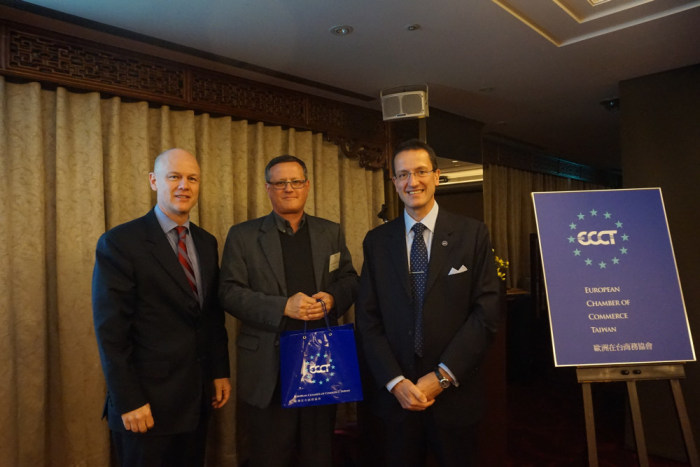Analysis of the TPP

On 23 February, the ECCT jointly hosted a Special Lunch with the Trade Office of Swiss Industries on the topic "What does the Trans-Pacific Partnership (TPP) have to do with free trade? - How the TPP will affect European companies with guest speaker Dr Patrick Ziltener, Associate Professor from the University of Zurich. The speaker provided some insights from a recently-concluded data-study he was involved in on the discrimination potential of the Trans-Pacific Partnership Agreement (TPPA) against Swiss companies on behalf of Switzerland Global Enterprise (S-GE) and the Swiss Federal Government's State Secretariat for Economic Affairs (SECO).
According to Ziltener, the TPP is more occupied with setting rules than with liberalizing trade, which makes a realistic assessment of its economic impact a difficult task. In his 13 January 2016 state-of-the-union speech, US President Obama said specifically that the TPP would allow the US to set the rules of the global economy, rather than allowing China to do so. Japanese Prime Minister Shinzo Abe expressed similar sentiments. Joseph Stiglitz went even further, suggesting that the agreement seeks to "manage TPP members' trade and investment relations and to do so on behalf of each country's most powerful business lobbies".
The agreement is immensely complex, including 30 chapters and running to over 6,000 pages. It is therefore not possible for one analyst to give a comprehensive analysis of the whole agreement. However, Ziltener gave his perspective on certain aspects that he has studied. Looking at the agricultural sector, he noted that trade liberalization measures in the TPP are very modest and protectionist systems will remain in place for agricultural produce from many countries.
One section of the TPP he believes is impressive is the Rules of Origin (RoO) chapter. Under the TPP there is one single set of RoOs. Inputs from one TPP party are treated the same as materials from any other TPP party, if they are used to produce a product in any TPP party. Moreover, there is a common TPP-wide system of showing and verifying that goods made in the TPP meet the rules of origin.
The TPP is likely to cause disruption of the car industry. Tariffs will be phased out gradually and the regional value content for finished vehicles will drop to 45% (compared to 62.5% under the NAFTA agreement) and 35-45% for auto parts. Japan, for example will be able to use regional supply chains in Asia to secure content for vehicles to be sold in the United States.
Ziltener questioned whether this would really promote free trade since the rules have been set by and favour dominant players. Even processing steps are defined, such as which parts can be used and only under which conditions, thereby disallowing the use of alternative supply chains. Nobody knows what impact the agreement will have on regional supply chains.
In the textile industry, while most tariffs would be eliminated immediately, there are exceptions for "sensitive" or "commercially significant", where tariffs will be phased out over 10-12 years. In addition there are complicated rules of origin and safeguards to protect local players.
Another section that Ziltener described as impressive is the Labour chapter, which would raise the bar for labour rights by enforcing labour rights and standards for all TPP signatories. Provisions include bans on child or forced labour and workplace discrimination, a minimum wage requirement, the right to form independent trade unions and workplace safety requirements. Trade sanctions can be imposed for violating labour rights.
Unlike a free trade agreement where tariffs are removed, it is very difficult to quantify how much TPP signatories will benefit from an agreement on rules and, conversely what the impact will be on non-TPP signatories. Traditional computable general equilibrium (CGE) models do not work well for the TPP. Those that have tried to devise quantifiable models have to make a number of subjective estimates and assumptions (for example, of the effects on output, productivity & wages across countries) that can significantly skew the results.
In addition, Ziltener noted that many companies do not take advantage of FTAs, which limits the impact of the FTAs. The same would apply to the TPP if not enough companies take advantage of it. Based on company survey results quoted by Ziltener, companies will only make use of FTAs if there is an incentive, it is convenient and routine. The major reasons for not using FTAs are no or low tariffs, low trade volume with FTA partner countries, a lack of knowledge or experience, rules of origin compliance costs and complicated procedures for obtaining the required certificate of origin. Moreover, TPP signatories are already members of the WTO and have other multilateral or bilateral agreements in place, which would not change with the TPP.
Looking at the example of Switzerland, Ziltener estimates that about 90% of all Swiss trade positions would not be affected by the TPP. However there are areas where TPP signatories will gain competitive advantages over parties outside the agreement, such as Japanese machinery exporters.
Taking all these factors into consideration Ziltener believes that the TPP's impact and reach will be less modest than the "big bang" it promises. Rather he sees it as a negotiated, managed liberalization that takes vested interests into consideration. In terms of broader implications, it is possible that certain uncontroversial TPP rules, such as those governing e-commerce, may be adopted by the WTO. However, there is unlikely to be any broader WTO adoption of the TPP's agreements on issues such as agriculture.
